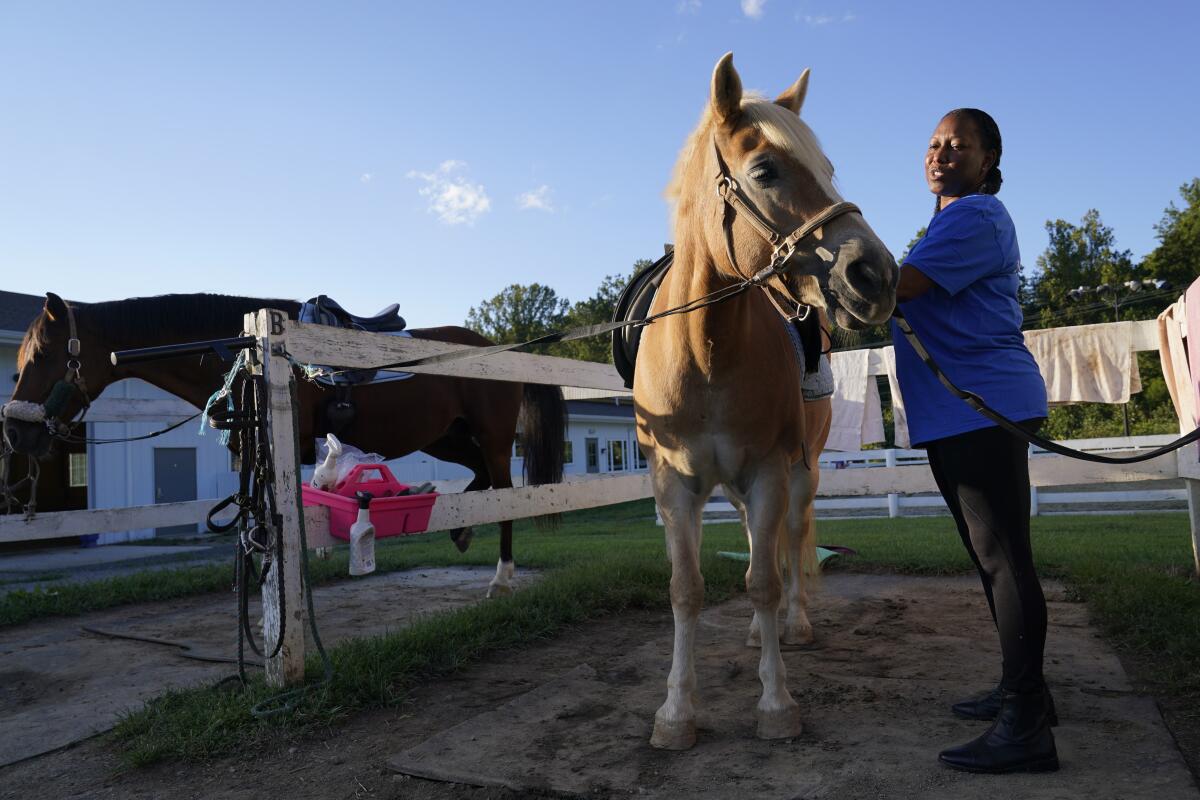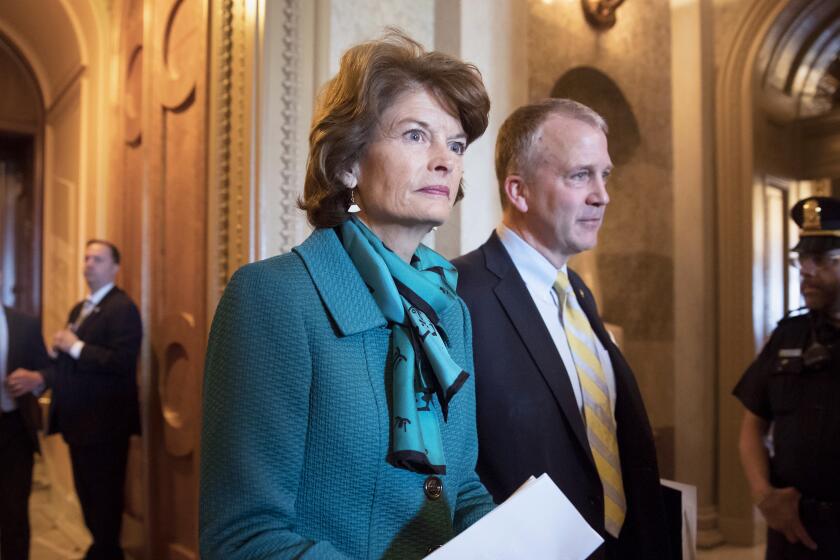Spiraling military suicide rates force Pentagon to address mental health

- Share via
WASHINGTON — After finishing a tour in Afghanistan in 2013, Dionne Williamson felt emotionally numb. More warning signs appeared during several years of subsequent overseas postings.
“It’s like I lost me somewhere,” said Williamson, a Navy lieutenant commander who experienced disorientation, depression, memory loss and chronic exhaustion. “I went to my captain and said, ‘Sir, I need help. Something’s wrong.’”
As the Pentagon seeks to confront spiraling suicide rates in the military’s ranks, Williamson’s experiences shine a light on the realities for service members seeking mental health help. For most, simply acknowledging their difficulties can be intimidating. And what comes next can be frustrating and dispiriting.
Williamson, 46, eventually found stability through a monthlong hospitalization and a therapeutic program that incorporates horseback riding. But she had to fight for years to get the help she needed. “It’s a wonder how I made it through,” she said.
In March, Defense Secretary Lloyd J. Austin III announced the creation of an independent committee to review the military’s mental health and suicide prevention programs.
According to Defense Department data, suicides among active-duty service members increased by more than 40% between 2015 and 2020. The numbers jumped by 15% in 2020 alone. In longtime suicide hotspot postings such as Alaska — where service members and their families contend with extreme isolation and a harsh climate — the rate has doubled.
New government research shows that female military veterans commit suicide at nearly six times the rate of other women, a startling finding that experts say poses disturbing questions about the backgrounds and experiences of women who serve in the armed forces.
A 2021 study by the Cost of War Project concluded that, since the Sept. 11, 2001, attacks, four times as many service members and veterans have died by suicide as have perished in combat. The study detailed stress factors particular to military life, citing “high exposure to trauma — mental, physical, moral, and sexual — stress and burnout, the influence of the military’s hegemonic masculine culture, continued access to guns, and the difficulty of re-integrating into civilian life.”
The Pentagon did not respond to repeated requests for comment. But Austin has publicly acknowledged that the Pentagon’s current mental health offerings — including a Defense Suicide Prevention Office established in 2011 — have proven insufficient.
“It is imperative that we take care of all our teammates and continue to reinforce that mental health and suicide prevention remain a key priority,” Austin wrote in March. “Clearly we have more work to do.”
Last year the Army issued fresh guidelines to its commanders on how to handle mental health issues in the ranks, complete with briefing slides and a script. But daunting long-term challenges remain. Many soldiers fear the stigma of admitting to mental health issues within a military culture of self-sufficiency. And those who seek help often find that stigma is not only real but compounded by bureaucratic obstacles.
For them, there was no retirement, no second career, no time spent watching their children grow.
As with the issue of food insecurity in military families, a network of military-adjacent charitable organizations has tried to fill the gaps with a variety of programs and outreach efforts.
Some are purely recreational, such as an annual fishing tournament in Alaska designed to provide fresh air and socialization for service members. Others are more focused on self-care, like an Armed Services YMCA program that offers free child care so that military parents can attend therapy sessions.
The situation in Alaska is particularly dire. In January, after a string of suicides, Command Sgt. Maj. Phil Blaisdell addressed his soldiers in an emotional Instagram post. “When did suicide become the answer?” he asked. “Please send me a DM if you need something. Please …”
Sen. Lisa Murkowski, a Republican who represents Alaska, said that while a posting in Alaska can be a dream for some service members, it’s a solitary nightmare for others that needs to be addressed.
Mental health news and resources to help you cope with the stress of daily life, anxiety and more.
“You’ve got to be paying attention to this when you see the statistics jump as they are,” Murkowski said. “You’ve got the Joint Chiefs looking at Alaska and saying, ‘Holy smokes, what’s going on up there?’”
The stresses of an Alaska posting are compounded by a shortage of on-the-ground therapists. During a visit to Joint Base Elmendorf-Richardson in Alaska earlier this year, Army Secretary Christine Wormuth heard from base healthcare workers who say they are understaffed, burned out and can’t see patients on a timely basis. A soldier who seeks help often has to wait weeks for an appointment.
“We have people who need our services and we can’t get to them,” one longtime counselor told Wormuth during a meeting. “We need staff, and until we get them, we will continue to have soldiers die.”
It’s not just in Alaska.
Two Russians who said they fled the country to avoid compulsory military service have requested asylum in the U.S.
Sgt. Antonio Rivera, an 18-year veteran who completed three tours in Iraq and a year at Guantanamo Bay in Cuba, freely acknowledges that he has serious PTSD.
“I know that I need help. There’s signs and I’ve waited long enough,” said Rivera, 48, who is assigned to Ft. Hood in Texas. “I don’t want my children to suffer because of me not going to get help.”
He’s doing yoga, but says he needs more. He’s reluctant to seek help inside the military.
“Personally I’d feel more comfortable being able to talk to someone outside,” he said. “It would allow me to open up a lot more without having to be worried about how it’s going to affect my career.”
News Alerts
Get breaking news, investigations, analysis and more signature journalism from the Los Angeles Times in your inbox.
You may occasionally receive promotional content from the Los Angeles Times.
Others who speak up say it’s a struggle to get assistance.
Despite the on-base presence of “tons of briefings and brochures on suicide and PTSD,” Williamson said she found herself fighting for years to get time off and therapy.
Eventually, she entered a monthlong in-patient program in Arizona. When she returned, a therapist recommended equine-assisted therapy, which proved to be a breakthrough.
Now Williamson is a regular at the Cloverleaf Equine Center in Clifton, Va., where riding sessions can be combined with a variety of therapeutic practices and exercises. Working with horses has long been a form for therapy for people with physical or mental disabilities and children diagnosed with autism. But in recent years, it has been embraced for helping service members with anxiety and PTSD.
According to one of the unsettling statistics cited in “Thank You for Your Service,” for every American soldier killed in combat, 25 die by suicide.
“In order to be able to work with horses, you need to be able to regulate your emotions. They communicate through body language and energy,” said Shelby Morrison, Cloverleaf’s communications director. “They respond to energies around them. They respond to negativity, positivity, anxiety, excitement.”
Military clients, Morrison said, come with “a lot of anxiety, depression, PTSD. … We use the horse to get them out of their triggers.”
For Williamson, the regular riding sessions have helped stabilize her. She still struggles, and she said her long campaign for treatment has damaged her relationship with multiple superior officers. She’s currently on limited duty and isn’t sure if she’ll retire when she hits her 20-year anniversary in March.
The equine therapy has helped her feel optimistic for the first time in recent memory.
“Now even if I can’t get out of bed, I make sure to come here,” she said. “If I didn’t come here, I don’t know where I would even be.”
More to Read
Sign up for Essential California
The most important California stories and recommendations in your inbox every morning.
You may occasionally receive promotional content from the Los Angeles Times.















